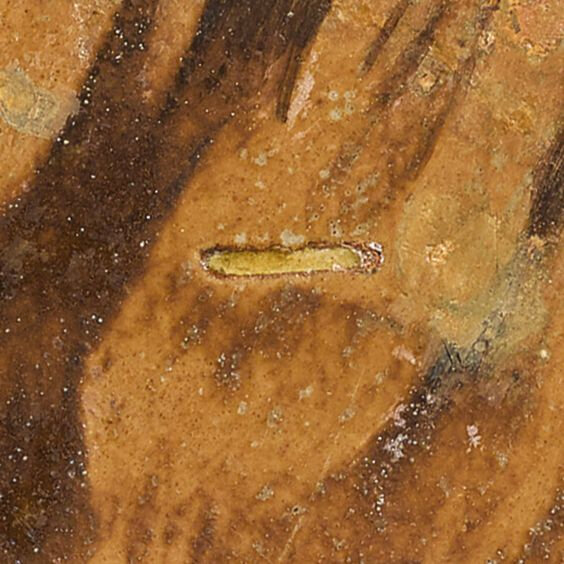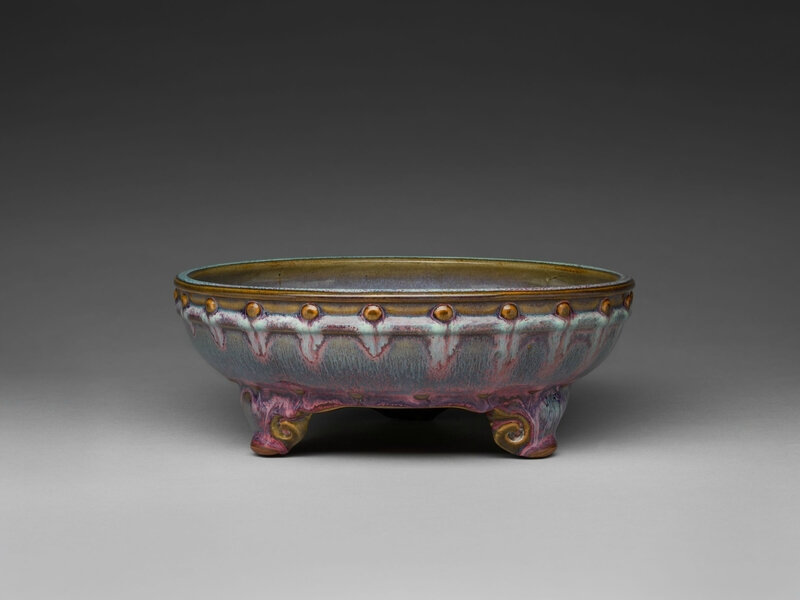of shallow circular form, the rounded sides gently curving to a flat recessed base supported on three ruyi-shaped feet, the mouth rim decorated with a band of evenly spaced bosses between two narrow raised bands, a further band of bosses above the feet, the glaze on the interior of a milky-blue color, the exterior a vivid purple thinning to a mushroom tone on the bosses, the thick glaze coagulating in droplets around the exterior, the base covered in a brown dressing and incised with the character yi ('one').
Note: This narcissus bowl with purple-and-blue glaze combination embodies the essence of Jun ware, the beauty of which is in their robust forms and thick opaque glazes of varied bright blue colorations that thin to translucent around the rim and edges of the vessel. The inside of the present bowl features a milky-blue glaze infused with the characteristic markings that are known as ‘earthworm tracks'. The exterior is a dazzling, rich purple tone.
Two bowls of similar size, one incised with the numeral er (two) and the other with yi (one), in the Palace Museum, Beijing, are illustrated in Selection of Jun Ware. The Palace Museum’s Collection and Archaeological Excavation. Beijing, 2013, pls 94 and 95; another, also incised with the number yi (one), but covered in sky-blue glaze, in the National Palace Museum, Taipei, is published in A Panorama of Ceramics in the Collection of the National Palace Museum: Chun Ware, Taipei, 1999, pl. 28, together with further examples inscribed with different numbers, pls 27-31 and 34-36. Compare also a bowl sold at Christie’s Hong Kong, 1st May 1995, lot 637, and again in our Hong Kong rooms, 7th May 2002, lot 521.
Mold-made vessels of this type are frequently incised with numbers from one to ten on the base. The significance of the inscribed numbers is poorly understood. The numbers coincide roughly with different sizes, yi ('one') being the largest and shi ('ten') the smallest version of the shape. This system would help to match sets of flower pots and their stands but does not explain the appearance of numbers on the base of vases and bulb bowls, such as the present bowl, which generally are stand-alone vessels. For further information see George J. Lee, 'Numbered Chun Ware', Transactions of the Oriental Ceramic Society, vol. 21, 1945-46, p. 61, which records five 'numbered Jun' vessels from the collection of Ernest B. and Helen Pratt Dane, possibly one of the most important collectors of 'numbered Jun' wares outside China, and now in the Harvard University Art Museums, Cambridge, MA.
Sotheby's. Important Chinese Art, New York, 12 sept. 2018, 10:30 AM

/https%3A%2F%2Fprofilepics.canalblog.com%2Fprofilepics%2F1%2F0%2F100183.jpg)
/https%3A%2F%2Fstorage.canalblog.com%2F03%2F02%2F119589%2F96711876_o.jpg)
/https%3A%2F%2Fstorage.canalblog.com%2F11%2F31%2F119589%2F94773502_o.jpg)
/https%3A%2F%2Fstorage.canalblog.com%2F20%2F83%2F119589%2F94772815_o.jpg)
/https%3A%2F%2Fstorage.canalblog.com%2F26%2F72%2F119589%2F75604929_o.jpg)
/https%3A%2F%2Fstorage.canalblog.com%2F59%2F60%2F119589%2F26458628_o.jpg)










/http%3A%2F%2Fstorage.canalblog.com%2F37%2F08%2F119589%2F127311075_o.jpg)
/http%3A%2F%2Fstorage.canalblog.com%2F13%2F81%2F119589%2F107028409_o.jpg)
/http%3A%2F%2Fstorage.canalblog.com%2F29%2F74%2F119589%2F106571264_o.jpg)
/http%3A%2F%2Fstorage.canalblog.com%2F71%2F03%2F119589%2F106571185_o.jpg)